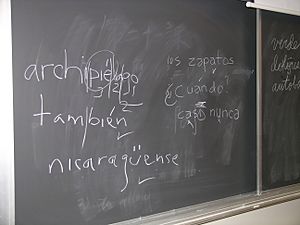Language transfer facts for kids

Language transfer is when you use what you already know about one language to help you learn another one. This can be really helpful, like when words or grammar rules are similar. But sometimes, it can also make things confusing or lead to mistakes if the languages are very different. It's a natural part of learning a new language!
Contents
What is Language Transfer?
Language transfer happens all the time when people learn a second language. Your brain naturally tries to connect new information with what it already knows. So, when you start learning a new language, your brain often uses the rules and sounds from your first language as a starting point. This process can either make learning easier or harder.
How Language Transfer Helps (Positive Transfer)
Sometimes, your first language can give you a big advantage. This is called positive transfer. It happens when your first language (L1) and the new language you're learning (L2) have similar features.
Similar Words (Cognates)
Many languages share words that look or sound alike and have similar meanings. These are called cognates. For example, if you speak English, you might find it easier to learn words in Spanish like "chocolate" or "hospital" because they are very similar to their English versions. This makes learning new vocabulary much faster.
Similar Grammar Rules
If two languages have similar grammar structures, learning the new language can be simpler. For instance, both English and German often follow a "subject-verb-object" word order (like "I eat apples"). If you speak English, this similarity can help you understand and form sentences in German more easily.
When Language Transfer Causes Problems (Negative Transfer)
On the other hand, language transfer can sometimes cause difficulties. This is known as negative transfer or interference. It happens when the rules or sounds from your first language are different from the new language, and you accidentally apply the wrong rule.
Different Pronunciation
Every language has its own unique sounds. If a sound doesn't exist in your first language, it can be hard to make it correctly in a new language. For example, some English speakers might struggle with the rolling "r" sound in Spanish, because it's not common in English.
Tricky Grammar Rules
Word order and grammar rules can be very different between languages. A common example is how age is expressed. In English, we say "I am 15 years old." But in Spanish, you say "Tengo 15 años," which directly translates to "I have 15 years." A Spanish speaker learning English might accidentally say "I have 15 years" because they are transferring the grammar rule from their first language.
False Friends
Some words look or sound similar in two languages but have completely different meanings. These are called false friends. For example, the Spanish word "embarazada" looks like "embarrassed" in English, but it actually means "pregnant." If you're not careful, using a false friend can lead to funny or confusing misunderstandings!
Why Does Language Transfer Happen?
Language transfer is a natural part of how our brains learn. When we encounter something new, our brain tries to make sense of it by relating it to what we already know. It's like building a new house using some of the tools and plans from a house you built before. Sometimes the old tools are perfect, and sometimes they just don't fit the new design.
Understanding language transfer can help you become a better language learner. When you know that your first language might sometimes help and sometimes hinder, you can pay more attention to those tricky areas and celebrate the easy ones!

